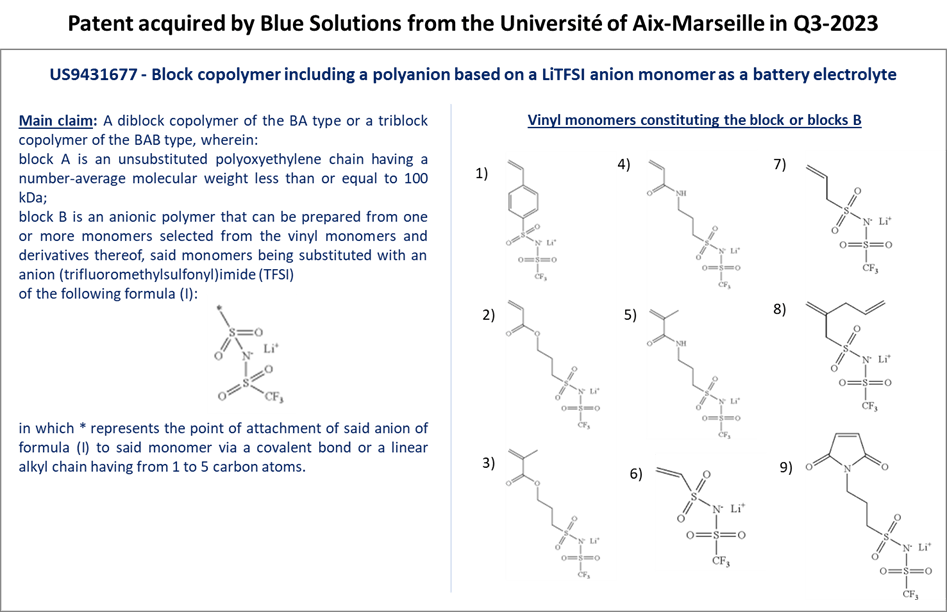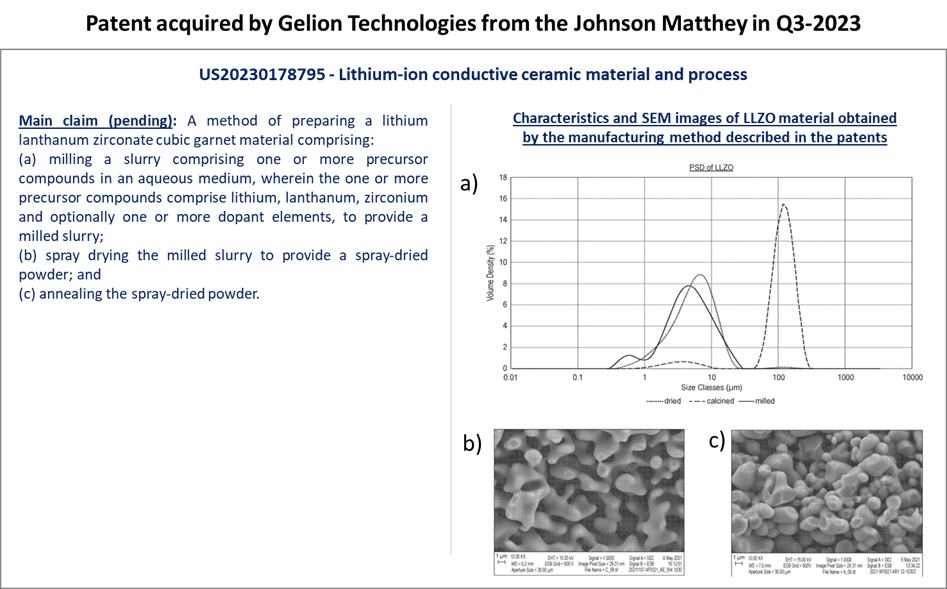SOPHIA ANTIPOLIS, France – October 30, 2023 │The quarterly report for the Q3 2023 Solid-State Li-ion Batteries patent monitor is now available! This report covers all aspects of Solid-state Li-ion batteries from solid electrolyte materials to their use in electrode, battery cells and packs.
This quarter, let us shine a spotlight on two notable transfers of patents claiming solid electrolyte materials, one from the University of Aix-Marseille to Blue Solutions, the other from Johnson Matthey to Gelion Technologies.
Exploring the thriving activity of solid-state batteries innovations
Solid-state Li-ion batteries hold a key position in the booming developments to get safer Li-ion batteries with higher energy density and fast charging capability for electric vehicles. In this fast-evolving context, it is essential to monitor the patent activity related to solid-state Li-ion batteries in order to understand the intellectual property (IP) position and strategy of the different players, and to be mindful of weak signals that could shape the future of batteries technology and industry.
In the third quarter of 2023, we witnessed the publication of over 790 new patent families (i.e., new inventions) related to solid-state batteries. At the same time, more than 370 patent families were newly granted (i.e., at least one member of the family granted for the first time), while about 20 patents expired or were abandoned. Finally, we identified over 110 IP newcomers and 4 new patent transfers in the solid-state batteries patent landscape.
KnowMade has developed a strong expertise in solid-stale Lion-batteries, which enables detailed pictures of this new technology, thanks to thorough IP landscape reports including Solid-State Li-ion Batteries (2021) and Solid Electrolytes for Li-ion Solid-State Batteries (2019). The monitoring activity begins from these starting points, and follows new inventions (i.e., new patent applications), newly granted IP rights, expired or abandoned patents, and new litigations in the US and Europe. The fine-tuned segmentation of KnowMade’s monitoring activity allows a comprehensive understanding of current technological sectors in solid-state Li-ion batteries. This survey encompasses all levels of the supply chain, from solid electrolyte materials to their use in electrodes, battery cells and packs, as well as key inorganic solid electrolyte materials such as Argyrodite, Thio-LISICON, Sulfide Glass Ceramic, Oxide Glass Ceramic, Perovskite, Anti-perovskite, LISICON, Garnet, NASICON, and more.
Blue Solutions acquired patent on solid polymer electrolyte from Aix-Marseille University.
Bolloré’s subsidiary Blue Solutions acquired patents on solid polymer electrolyte from the University of Aix-Marseille in July 2023. Blue Solutions is a French battery manufacturer founded in 2001 as Batscap and part of Bolloré group. In 2007, Blue Solutions acquired Avestor, a joint-venture between HydroQuebec and Kerr Mc Gee Chem. It is specialized in polymer solid-state Li-ion batteries. The patents involved in the transfer were filed by Aix-Marseille University in 2012 via a Patent Cooperation Treaty (PCT) procedure (representative member of the family: US9431677). The patent family comprises several patent applications granted in the US, Europe (France, Germany, UK, Switzerland, Spain, Italy), China, Japan, South Korea and Canada.
The invention pertains to a specific solid electrolyte polymer material and its use in solid-state polymer batteries. The patented solid electrolyte polymer comprises a BA diblock or BAB triblock copolymer including a polyanion based on LiTFSI anion monomer. In this polymer, the A block is a non-substituted poly-oxyethylene chain having a mean molecular weight that is no higher than 100 kDa, and the B block is an anionic polymer which can be prepared using one or more monomers selected from among the vinyl monomers and derivatives thereof, said monomers being substituted with a (trifluoromethylsulfonyl)imide (TFSI) anion. Compared to polymers commonly used in solid-state polymer batteries, this claimed polymer has an improved ionic conductivity, a higher lithium ion transfer number and better mechanical durability. It also has a high thermal stability (which ensures safety of the energy storage devices comprising them), and improved stability of potential.

Figure 1: University of Aix-Marseille’s patent acquired by Blue Solutions in Q3-2023. Main claim and block copolymer covered by the patent US9431677.
The tests described in the patent US9431677 show that the use of these copolymers as polymer solid electrolyte in a lithium metal battery leads to an energy storage device having excellent performance at low temperature (about 60° C.), in particular a lithium ion transfer number above 0.84, and an ionic conductivity of 10−5 S.cm−1 at 60° C. The high transfer number makes it possible to limit the development of concentration gradients in the electrolyte during discharge (or during charging) allowing the power performance to be increased (or the charging rate). The use of these copolymers as polymer solid electrolyte in a lithium metal battery also makes it possible to limit dendritic growth of the lithium and thus envisage quick and safe recharging. In fact, the problem with the technology of lithium metal batteries is the formation of heterogeneous electrodeposits of lithium (including dendrites) during recharging, which decreases the cycle life and can lead to short-circuits. Moreover, these polymers are stable up to 4.5 V vs Li+/Li. Their use as electrolyte in a battery composed of lithium for the anode and LiFePO4 for the cathode leads to a device having very good capacity behavior (retention of more than 90% of the capacity at C/2 regardless of the test temperature, and 80% in a C regime).
It is worth to note that more than 80+ new patent applications on polymer solid electrolyte materials were published in Q3-2023, mainly from Chinese entities Tongji University, Chonqing Tailan New Energy, Fuzhou University, Xiamen University, Envision, etc.
Gelion Technologies acquired patent on Lithium-ion conductive ceramic material from Johnson Matthey
Gelion Technologies acquired patent applications (still pending) on Lithium-ion conductive ceramic material from Johnson Matthey (JM) in September 2023. Johnson Matthey is a British material and battery manufacturer founded in 1917. The company operates on both electrical batteries and fuel cells. In 2014, JM acquired Clariant’s battery material business including its subsidiary Phostech Lithium. Previouly, Clariant acquired Süd Chemie in 2011. Phostech Lithium, founded in 2001, was acquired by Süd Chemie in 2008 after several years of partnerships. In 2018, Cummins announces the acquisition of Johnson Matthey’s U.K. automotive battery systems business. In 2022, Johnson Matthey announced the sale of its battery materials division. Gelion Technologies (www.gelion.com) is an Australia-British battery manufacturer, specializing in Li-S batteries, founded in 2015 as a spin-out from the University of Sydney. In 2023, Gelion Technologies acquired Johnson Matthey’s entire Lithium Sulfur and Silicon Anode patent portfolio (see the press release). The solid-state battery related patents acquired this quarter may also be part of this deal (pending patent applications WO2021/224637, US20230178795, and EP4146613, filed in 2021 by Johnson Matthey).
These patents claim a Lithium Lanthanum Zirconate cubic garnet material (Li7La3Zr2O12 or LLZO) that can be used as Li-ion conductive solid electrolyte in secondary Lithium-ion batteries as well as its manufacturing method. The claimed manufacturing method is made up of three steps. First, a slurry containing one or more precursor compounds, comprising lithium, lanthanum, zirconium, and potentially additional dopant elements, is milled in an aqueous medium to form a milled slurry. Next, the milled slurry is spray dried to provide a spray-dried powder. Finally, the spray-dried powder is annealed.

Figure 2: Lithium Lanthanum Zirconate Garnet solid electrolyte material and its manufacturing method covered by the pending patent application US20230178795 acquired by Gelion Technologies from the Johnson Matthey:
a) PSD plots for (i) the spray-dried precursor material before annealing, (ii) the annealed product before milling, and (iii) the annealed and milled final product.
b) Cross-sectional SEM images of a sintered LLZO material formed from hydroxide precursor materials.
c) Cross-sectional SEM images of a sintered LLZO material oxide precursor materials.
Compared to other manufacturing methods of LLZO, this method is more efficient, easily scalable and provides a material with a high Li-ion conductivity. In fact, known manufacturing methods of LLZO typically use solid state synthesis which require treatment at very high temperature and/or multiple annealing or grinding steps to obtain a product containing the desired LLZO phase. By contrast the present invention provides a method in which an aqueous slurry is milled, spray dried and annealed to obtain the desired product. This offers a significant reduction in energy requirements and therefore manufacturing cost, allowing the process to be easily scaled up to prepare LLZO on a commercial scale. Furthermore, known methods of LLZO preparation typically involve the heat treatment of precursor materials and/or the use of fine precursor particles with a homogeneous particle size distribution. The inventors of the present invention have found that precursor materials which have not been subjected to any pre-treatment may be successfully used in the current process, and in addition that large and inhomogeneously distributed precursor particles may be utilized without detriment, further enhancing process efficiency and reducing cost of production. A further benefit of the invention is that limited chemical waste is generated from the aqueous milling step, providing a process which is more efficient and environmentally friendly. It is worth to note that Garnet is one the inorganic solid electrolyte material showing the highest patenting activity for the last two years.
It is worth to note that more than 30+ new patent applications on Garnet solid electrolyte materials were published in Q3-2023, mainly from Chinese entities Beijing University of Technology, Gansu Guangxuan High End Equipment Industry, GRIREM Hi Technology, Tungshu, etc.
The Solid-State Li-ion Batteries Quarter Patent Monitor provides up-to-date data on patent activity, and it allows you to take advantage of a quarterly-updated Excel database and benefit from both quarterly analysis reports and direct access to our analysts for on-demand discussions regarding the results, trends, specific patented technologies, or companies’ patent portfolios in the field of solid-state batteries.
If you need more information, reach us at contact@knowmade.fr or with our contact forms.
Press contact
contact@knowmade.fr
Le Drakkar, 2405 route des Dolines, 06560 Sophia Antipolis, France
www.knowmade.com
About the author
Fleur Thissandier, PhD, works for Knowmade in the field of Materials Chemistry and Energy storage. She holds a PhD in Materials Chemistry and Electrochemistry from CEA/INAC, (Grenoble, France). She also holds a Chemistry Engineering Degree from the Superior National School of Chemistry (ENSCM Montpellier, France). Fleur previously worked in battery industry as R&D Engineer.
About KnowMade
KnowMade is a Technology Intelligence and IP Strategy consulting company specialized in analyzing patents and scientific publications. The company helps innovative companies, investors, and R&D organizations to understand their competitive landscape, follow technological evolutions, reduce uncertainties, and identify opportunities and risks in terms of technology and intellectual property.
KnowMade’s analysts combine their strong technology expertise and in-depth knowledge of patents with powerful analytics tools and methodologies to turn patent information and scientific literature into actionable insights, providing high added value reports for decision makers working in R&D, innovation strategy, intellectual property, and marketing. Our experts provide prior art search, patent landscape analysis, freedom-to-operate analysis, IP due diligence, and monitoring services.
KnowMade has a solid expertise in Compound Semiconductors, Power Electronics, Batteries, RF Technologies & Wireless Communications, Solid-State Lighting & Display, Photonics, Memories, MEMS & Sensors, Semiconductor Packaging, Medical Devices, Medical Imaging, Microfluidics, Biotechnology, Pharmaceutics, and Agri-Food.
